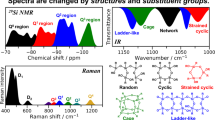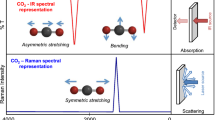Abstract
Distortions of peaks can occur when one uses the standard method of signal processing of data from the Orbitrap and other FT-based methods of mass spectrometry. These distortions arise because the standard method of signal processing is not a linear process. If one adds two or more functions, such as time-dependent signals from a Fourier transform mass spectrometer and performs a linear operation on the sum, the result is the same as if the operation was performed on separate functions and the results added. If this relationship is not valid, the operation is non-linear and can produce unexpected and/or distorted results. Although the Fourier transform itself is a linear operator, the standard algorithm for processing spectra in Fourier transform-based methods include non-linear mathematical operators such that spectra processed by the standard algorithm may become distorted. The most serious consequence is that apparent abundances of the peaks in the spectrum may be incorrect. In light of these considerations, we performed theoretical modeling studies to illustrate several distortion effects that can be observed, including abundance distortions. In addition, we discuss experimental systems where these effects may manifest, including suggested systems for study that should demonstrate these peak distortions. Finally, we point to several examples in the literature where peak distortions may be rationalized by the phenomena presented here.

ᅟ






Similar content being viewed by others
References
Smith, S.W.: The Scientists’ and Engineers’ Guide to Digital Signal Processing, pp. 185–208. California Technical Publishing, San Diego (1997)
Ilchenko, S., Previs, S.F., Rachdaoui, N., Willard, B., McCullough, A.J., Kasumov, T.: An improved measurement of isotopic ratios by high resolution mass spectrometry. J. Am. Soc. Mass Spectrom. 24, 309–312 (2013)
Greene, J.R., Francisco, J.S., Huang, J., Xu, D., Jackson, W.M.: Photodissociation studies of CBr4+ and CBr3+ at 267 nm using ion velocity imaging. J. Chem. Phys. 121, 5868–5873 (2004)
Easterling, M.L., Amster, I.J., Van Rooj, G.J., Heeron, R.M.A.: Isotope beating effects in the analysis of polymer distributions by Fourier transform mass spectrometry. J. Am. Soc. Mass Spectrom. 10, 1074–1081 (1999)
Blake, S.W., Walker, S.H., Muddiman, D.C., Hinks, D., Beck, K.R.: Spectral accuracy and sulfur counting capabilities of the LTQ-FT-ICR and the LTQ-Orbitrap XL for small molecule analysis. J. Am. Soc. Mass Spectrom. 22, 2269–2275 (2011)
Erve, J.C.L., Gu, M., Wang, Y., DeMaio, W., Talaat, R.E.: Spectral accuracy of molecular ions in an LTQ/Orbitrap mass spectrometer and implications for elemental composition determination. J. Am. Soc. Mass Spectrom. 20, 2058–2069 (2009)
Rockwood, A.L., Van Orden, S.L., Smith, R.D.: Ultrahigh resolution isotope distribution calculations. Rapid Commun. Mass Spectrom. 10, 54–59 (1998)
Shi, S.D.-H., Hendrickson, C.L., Marshall, A.G.: Counting individual sulfur atoms in a protein by ultrahigh resolution Fourier transform ion cyclotron resonance mass spectrometry: experimental resolution of isotopic fine structure in proteins. Proc. Natl. Acad. Sci. U. S. A. 95, 11532–11537 (1998)
Popov, I.A., Nagornov, K., Vladimirov, G.N., Kostyukevich, Y.I., Nikoleav, E.N.: Twelve million resolving power on a 4.7 T Fourier transform ion cyclotron resonance instrument with dynamically harmonized cell—observation of fine structure in peptide mass spectra. J. Am. Soc. Mass Spectrom. 25, 790–799 (2014)
Peurrung, A.J., Kouzes, R.T.: Analysis of space-charge effects in cyclotron resonance mass spectrometry as coupled gyrator phenomena. Int. J. Mass Spectrom. Ion Process. 145, 139–153 (1995)
Mitchell, D.W., Smith, R.D.: Cyclotron motion of two Coulombically interacting ion clouds with implications to Fourier-transform ion cyclotron resonance mass spectrometry. Phys. Rev. E. 52, 4366–4386 (1995)
Boldin, I.A., Nikolaev, E.N.: Theory of peak coalescence in Fourier transform ion cyclotron resonance mass spectrometry. Rapid Commu. Mass Spectrom. 23, 3213–3219 (2009)
Mathur, R., O’Connor, P.B.: Artifacts in Fourier transform mass spectrometry. Rapid Commun. Mass Spectrom. 23, 523–529 (2009)
Harris, F.J.: On the use of windows for harmonic analysis with the discrete Fourier transform. Proc. IEEE 66, 51–83 (1978)
Available at: http://en.wikipedia.org/wiki/Spectral_leakage. Accessed July 4 (2014)
Qi, Y., Thompson, C.J., Van Orden, S.L., O’Connor, P.B.: Phase correction of Fourier transform ion cyclotron resonance mass spectra using MatLab. J. Am. Soc. Mass Spectrom. 22, 138–147 (2011)
Qi, Y., O’Connor, P.B.: Data processing in Fourier transform ion cyclotron resonance mass spectrometry. Mass Spectrom. Rev. 33, 333–352 (2014)
Qi, Y., Li, H., Wills, R.H., Perez-Hurtado, P., Yu, X., Kilgour, D.P.A., Barrow, M.P., Lin, C., O’Connor, P.B.: Absorption-mode Fourier transform mass spectrometry: the effects of apodization and phasing on modified protein spectra. J. Am. Soc. Mass Spectrom. 24, 828–834 (2013)
Acknowledgments
The authors gratefully acknowledge financial support from ARUP Laboratories.
Author information
Authors and Affiliations
Corresponding author
Rights and permissions
About this article
Cite this article
Rockwood, A.L., Erve, J.C.L. Mass Spectral Peak Distortion Due to Fourier Transform Signal Processing. J. Am. Soc. Mass Spectrom. 25, 2163–2176 (2014). https://doi.org/10.1007/s13361-014-0982-0
Received:
Revised:
Accepted:
Published:
Issue Date:
DOI: https://doi.org/10.1007/s13361-014-0982-0




